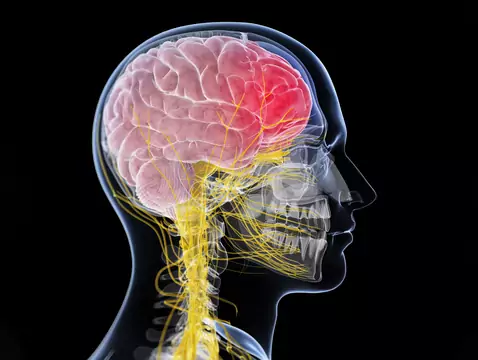
Brain aneurysm - causes, symptoms, diagnosis, treatment
We define an aneurysm as an acquired or congenital, widening of the lumen of an arterial vessel that is filled with blood. It is formed in the vessel wall (in an inflammationally or traumatically...

Dizziness - causes, symptoms, diagnosis, treatment
Dizziness is a common and well-known ailment of people of all ages. It is not a disease but a symptom experienced by each patient individually. There may be many reasons for their occurrence and,...

Kimmerli's anomaly - causes, symptoms, diagnosis, treatment
Kimmerle's anomaly (a.k.a. arch hole, sagittal hole) is a condition in which the groove of the vertebral artery remains completely or partially obstructed as a result of a calcified ligament or...

Transient ischaemic attack (TIA) - causes, symptoms, diagnosis, treatment
We define a transient ischaemic attack (TIA, transient ischaemic attacks) as an interruption of oxygen supply to the brain, involving an area of a single vascularisation, which usually lasts from a...

Multiple sclerosis and pregnancy
Multiple sclerosis (S) is a lifelong inflammatory-demyelinating disease. It also affects women who are of childbearing age. The disease is characterised by damage to nerve conduction, which impairs...

Amyotrophic lateral sclerosis - causes, symptoms, diagnosis, treatment
Amyotrophic lateral sclerosis (MND) is a disease that attacks a person's nervous system (both peripheral and central) and leads to slow, gradual muscle atrophy.

Multiple sclerosis and physical activity
Multiple sclerosis is a lifelong disease. The disease is characterised by periods of relapses (worsening of the patient's neurological condition) and remissions (resolution of relapses). It affects...

Sciatica - causes, symptoms, diagnosis, treatment
Sciatica is a very common condition. Its well-known symptom is severe pain that tends to move and, importantly, radiates along the sciatic nerve. Most often patients feel it in the back of the leg,...

Serotonin syndrome: incidence, symptoms, management
What is serotonin syndrome - a complication of the treatment of depression with drugs with a serotonin mechanism of action, especially from the group of so-called SSRIs. SSRIs(selective serotonin...

Frontotemporal dementia
Research has identified a form of dementia caused by a degenerative process separate from Alzheimer's disease.

Alexia - inability to understand the written word - causes, symptoms, diagnosis, treatment
The disorder called alexia is most often acquired rather than congenital. It is an inability to read the written word with an accompanying inability to write. There are cases where it is a...

Canavan disease - causes, symptoms, diagnosis, treatment
Canavan disease (spongiform degeneration of the nervous system) is classified as a degenerative disease of the central nervous system (CNS), genetically determined, incurable. It leads to...

Narcolepsy - causes, symptoms, diagnosis, treatment
Narcolepsy is defined as a syndrome whose aetiology is as yet not well understood. It is currently considered to be a neurological syndrome, although research into the influence of genes on its...

Tourette syndrome - causes, symptoms, diagnosis, treatment
Tourette syndrome (TMS) is classified as a congenital neurological disorder. It is a tic disorder. People affected by this condition are not mentally ill and dangerous as once thought. At present, it...

When does cognitive dysfunction begin?
Cognitive functions, otherwise known as cognitive processes, serve to create and modify knowledge about the environment, and this is what models our behaviour.

Bacterial meningitis - causes, symptoms, diagnosis, treatment
Bacterial meningitis is a very dangerous disease that requires necessary hospital treatment. It is an infectious disease that, if untreated, can lead to death. Microorganisms penetrate the...

Leber's optic nerve neuropathy - causes, symptoms, diagnosis, treatment
Leber hereditary neuropathy of the optic nerve is a mitochondrial disease associated with various types of disorders and abnormalities in the structure and function of mitochondria. The disease is...

Narcolepsy - causes, symptoms, diagnosis, treatment
Narcolepsy is a sudden onset, uncontrollable sleep that lasts about 20 minutes. It is a condition that is not controlled by the person and can actually happen anywhere (on the bus, during a phone...

Autoimmune diseases of the nervous system
An autoimmune disease is a condition in which the immune system produces antibodies against its own tissues, causing an inflammatory response.

All about cerebral hemangiomas
Cerebral hemangiomas, or vascular malformations, are congenital or acquired malformations of the cerebral vasculature, arising mainly during fetal development, during the formation of the cerebral...



